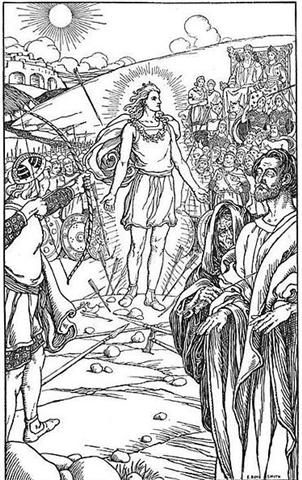The end of side a of the tablet reaches to 'January 8 and it would not be surprising if the Gregorian calendar continued on side b, because the beginning of the Gregorian calendar is not at the beginning of side a. Furthermore, the name Easter Island ought to have induced the creator of the text to continue and not to end prematurely in January, before reaching the resurrection.
In addition to the distances measured out by the first 3 + 4 = 7 Rei glyphs leading from St John's Eve and forward (70 + 100 = 170 days), we have to add the last 5 Rei to complete our list:
Possibly July 20 has to do with preparations for the feast of St James (the twin brother of St John), because his feast is celebrated in July 25, where the distance from equinox is 126 days (= 2 * 63):
From July 25 (206) to September 17 (260, like a reshuffled 206) there are 54 (= 2 * 27) days, though perhaps not alluded to by Rei at Ga2-27, because 22 / 7 definitely means π (especially as we suspect the henua calendar is beginning 4 days later). There are 5 days also from 'September 12 to 'September 17:
And from 'September 17 to 'December 17 there are 91 (= 7 * 13) days, equal to the distance from 'September 1 to 'December 1.
A pattern 3 + 4 + 5 can be used to indicate a gradual increase. South of the equator the day for Sun's rebirth could come with St John's Eve. If so, then midsummer down there would arrive 355 - 174 = 181 days later, equally long as the time from Aldebaran to Antares:
From 'June 21 to the heliacal rising of Antares there were 329 - 172 = 157 days and this fact presumably was regarded as a Sign of π (because 314 / 2 = 157). It could have suggested the precession had moved the stars a quarter of the solar year ahead and that the star dome had been constructed around 72 * 91 = 6.552 years ago or around 4700 B.C. Although the author of the G text may have thought otherwise, because precession would have moved the Hyadum twins ahead from equinox in around 72 * (144 - 80) = 4.608 years, pointing at a more recent time of creation around 2700 B.C. (when Taurus ruled):
There are plenty of mata ('eye') signs in line a8.
These probably indicate plenty of light, resulting in a great growth. The solstice day is the central event according to the pattern of the group with 5 Rei signs. 18h was connected with the heliacal rising of π in the Peacock constellation:
Although the Peacock star itself (α Pavonis) was rising later, in 'January 24, its tiny beginning might have been with iota, a symbol for something very small. 8 * 8 = 64 (= 144 - 80). Side b ought to continue from side a with the nice and good (maitaki) summer days on Easter Island:
Day 374 (counted from the previous 'January 1) equals 174 (St John's Day) + 200. From 'June 23 to the solstice in 'December 21 there are 355 - 173 = 182 days, half a year, and from the solstice to 'January 9 there are 374 - 355 = 19 days.
Several strong Signs can easily be found in line b1, for instance:
The strongest of these Signs (arbitrary listed as 8 by me) is number 7, because the type of glyph is nowhere else in the rongorongo texts to be found. The position of Gb1-21 - where we can simply count 12 * 1 = 12, or alternatively identify 121 with 11 * 11 - is 314 days from 'March 21, certainly meant to be observed by the reader. The day number for January 29 (alluding to the dark night of Moon) = March 21 (80) + 314 = 394. This dark night coincides with the beginning of the manzil Al Baldaah. The meaning presumably is to state where the first cycle of the pair in a year is completed. Such a year could be e.g. 2 * 314 = 628 days long (equal to the number of glyphs on the E tablet). A new 'π half-circle' would then begin here. Possibly it ends with glyph number 251 + 314 - 472 = 93:
93 + 63 = 156 (= 12 * 13) and 156 + 80 = 236. The completed cycle of the Gregorian calendar (or rather the Julian calendar) measures 365¼ days, which is shorter than the cycle of glyphs on the G tablet. 394 (January 29) - 236 (August 24) = 158 (or slightly more than 314 / 2). 236 = 8 * 29½ and 236 is the glyph number for Gb1-6 (possibly to be read as 16, an allusion to the number of lines on the tablet). The preceding tagata means a season is fully grown and possibly the star Sham (α Sagittae) indicates the instrument by which the old season is 'finished'.
| ||||||||||||||||||||||||||||||||||||||||||||||||||||||||||||||||||||||||||||||||||||||||||||||||||||||||||||||||||||||||||||||||||||||||||||||||||||||||||||||||||||||||||||||||||||||||||||||||||||||||||||||||||||||||||||||||||||||||||||||||||||||||||||||||||||||||||||||||||||||||||||||||||||||||||||||||||||||||||||||||||||||||||||||||||||||||||||||||||||||||||||||||||||||




































